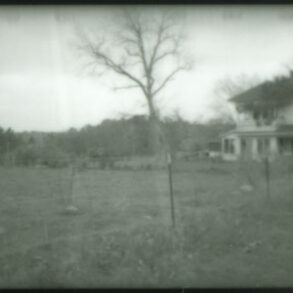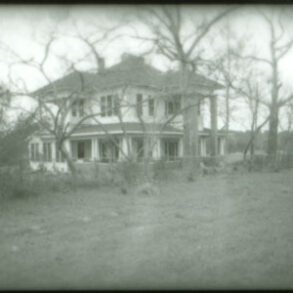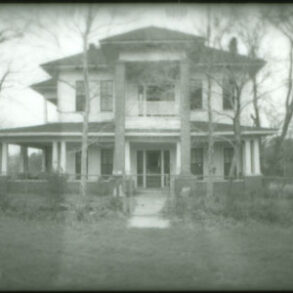Gibbs/Flournoy House1986 Survey Information
- Site No.: Z-1165
- Name: Gibbs/Flournoy House
- Date: Factual 1905; 1928
- Town: Manning
- Block: Lincoln Norris, Abst 878, Tract 2
- Condition: Fair
- Description: 2-story; wood frame with horizontal board siding; pier foundation; rectangular massed plan; hip roofs with hipped dormers extending out over porches on two sides, deep overhangs, composition shingles; two-story portico on front with brick columns, one-story porch on front wrapping around to southwest; paired battered boxed wood 1/2 columns resting on brick piers, low brick wall around porch, single entry door with screen door, wood-paneled door with upper glass light, side lights; windows 4/4 wood double-hung; two second story boxed balconies with dormers w/ simple wood railings, balcony only sw has boxed, battered wood porch supports; sun room on sw at 1st floor, 1 exterior brick chimney on east, 1 interior brick chimney on west; ridge cresting on dormers; ventilator cupola on crest of main hip roof; farm outbuilding at rear in poor condition.
- Significance: Home of the superintendent of the mill at Manning, Mr. W. M. Gibbs; good example of architectural style. Nominated to the National Register. The significance is industry and architecture. W. M. Gibbs was succeeded as manager by his son Ernest Gibbs. After the mill burned, he moved to Shawnee Prairie, n. of Manning, to operate a farm and cotton gin. The next owners were Morgan & Ruby Flournoy, who came to Manning in 1929 as teachers at the school. They raised 5 children. The house was also occupied by M. P. Flournoy, educated at Texas A&M, and an engineer at Lufkin Industries. The house is currently unoccupied. It is 1 of only 2 structures extant that represents the town of Manning. Manning was named for Dr. W. W. Manning, the founder of Homer. He established a sawmill at Manning in 1867; he later abandoned the site and established a newer, mechanical mill near Homer, Louisiana in 1903, W. T. Carter of Houston, and G. A. Kelley, of Lufkin organized Carter-Kelley Lumber Co. and built a large sawmill. In 1907 the Houston-Shreveport & Gulf Railroad was built at Huntington, 10 miles north of Manning, to connect with the Cotton Belt and T&NO Railroad; a spur was built to Manning for export of products. By 1910 the town had a population of 1300, 2/3 white, 1/3 black. During the 1920s, Manning was the second largest town in Angelina County with approximately 1500 residents. Lufkin had 5000, Diboll had 100, Huntington had 1000, and Zavalla had 600. The town was divided according to race and seniority at the sawmill. The white quarters were closer to the center of the town; the black quarters were across the pond north of the white section; the Italian quarters were east of the white quarters. The black quarters had school, churches, pool hall, barber shop, hotel, and cemetery. The business section of the town held the mill offices, commissary, post office, depot, drug store, barber shop, Masonic Lodge, and movie theatre. The white section had grammar and high school with seven teachers. Water was pumped from the mill pond, purified by condensing unit near the sawmill, and pumped to a water tower for gravity distribution. Only nicer homes had running water inside; others had a hydrant or faucet in the yard. Some homes were provided with electricity from a generator; however, most used coal oil lamps. Ice was delivered to the commissary by rail for purchase by residents. Workers were paid in checks, brass coins, redeemable only at Manning or nearby. The mill was one of the largest in East Texas. It was equipped with a double band saw and planer mill; logs were brought from woods on flat cars and rolled off into the mill pond; a conveyor transported the logs to band saws. The layout of the mill can clearly be seen on the early 1937 aerial photographs. Before it closed, the mill had a capacity of 34 million board feet of lumber a year and employed 300 men. The mill burned in January 1936 and was soon abandoned. The effects of the fire, the Great Depression, and the heavy timber cutting, caused the owners to concentrate their activities at Camden 30 miles west of Manning.
Designed by Elegant Themes | Powered by Wordpress





Recent Comments